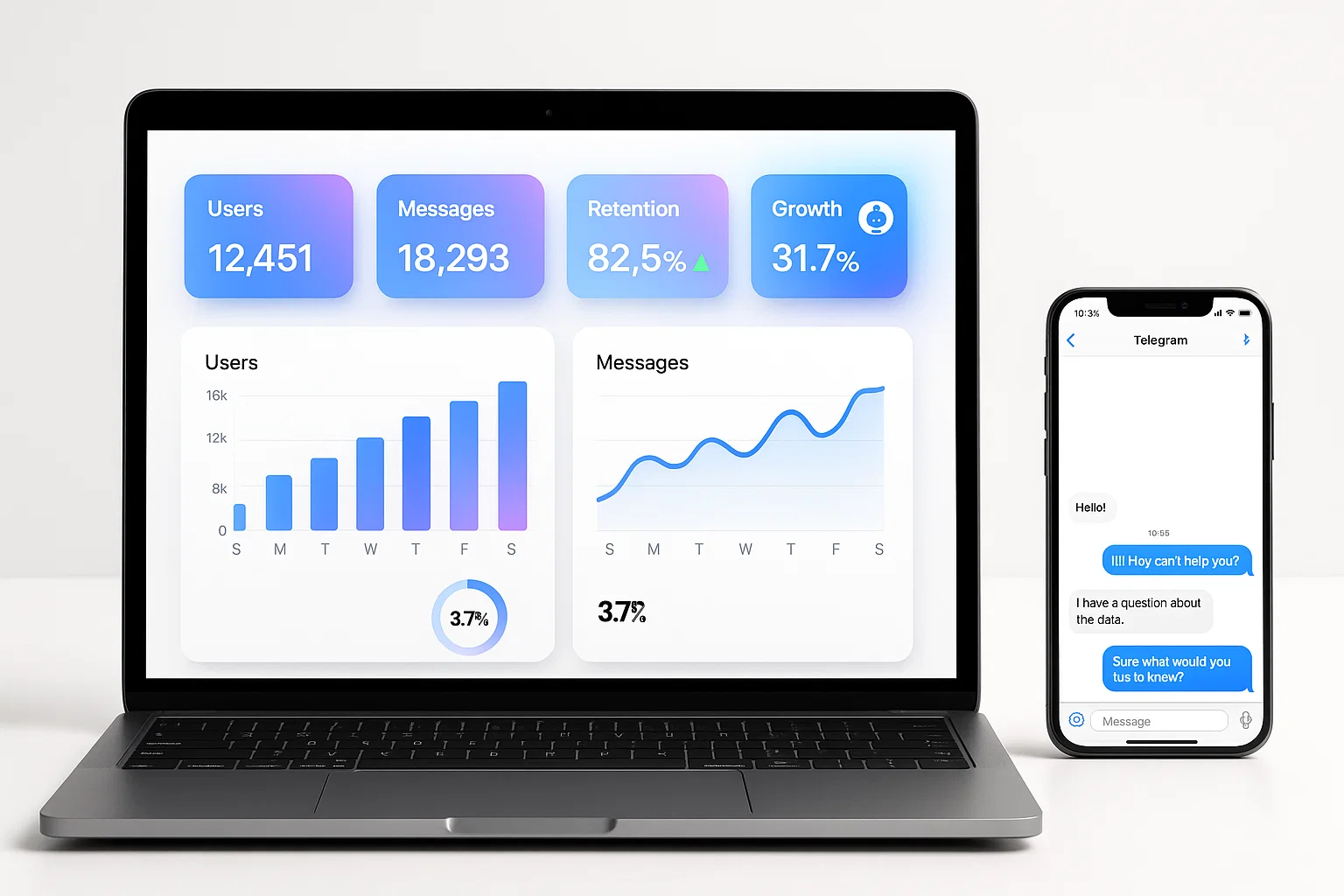Telegram bots stats show how users interact with your bot, tracking messages, sessions, retention and conversion, so you can prioritize features, reduce churn, and make data driven product decisions fast.
Introduction
telegram bots stats are the baseline for building better bots, they tell you who uses your bot, how often, and what features drive value. This guide is informational and practical, it shows you how to collect, analyze, and act on bot metrics using simple tooling and production tips. I’ll walk you through what to track, how to implement logging, sample code, and how to turn raw data into growth experiments. I mention telemetry tools like Prometheus and simple stores like SQLite early, because both fit common bot architectures and make rollout fast. In my experience, teams that instrument core events early ship better features and resolve bugs faster.
This article is written like a teammate, so you get direct, actionable steps you can implement today.
What telegram bots stats are, and why they matter
telegram bots stats are structured measurements of bot usage and performance. They range from basic counts, like total messages processed, to nuanced signals like retention, session length, and feature conversion.
Core metric categories
- User metrics, active users, new users, returning users.
- Engagement metrics, messages per session, commands used, reactions.
- Retention metrics, day 1, day 7 retention, churn rates.
- Performance metrics, latency, error rates, and API call quotas.
- Monetization metrics, conversions, paid feature adoption, ARPU.
Why measure telegram bots stats
You may think raw crash logs are enough, but telemetry uncovers product signals. Stats let you prioritize features that move the needle, detect regressions before users complain, and measure the impact of marketing or onboarding changes. For communities and paid products, metrics are the difference between guesswork and predictable growth.
How stats fit into the lifecycle
- Discovery, measure how users find the bot.
- Activation, track first successful action.
- Retention, see whether users come back.
- Revenue, measure purchases or upgrades.
Instrumentation reveals user intent and friction points, which improves decisions about features and messaging. (Google)
Consistent metrics definitions and logging practices reduce disputes and speed debugging. (Moz)
How to collect and analyze telegram bots stats
Below is a practical, step-by-step implementation you can use to collect metrics, run reports, and build dashboards.
Step 1: Define events and schemas
Start with 6 to 12 core events, for example:
user.registerwhen a user first interacts.session.startandsession.end.command.runwith command name.message.receivedwith length and type.purchase.completefor paid flows.
Define a small JSON schema for each event, including user_id, timestamp, context, and properties.
Step 2: Instrument the bot
Log events at the source, inside your bot code. Send events to a simple queue or directly to a datastore. Prefer batching to reduce load.
Minimal Python example, copy-paste
# python
# Simple event logger for a Telegram bot, stores events in SQLite
import sqlite3, time, json
from contextlib import closing
DB = 'bot_stats.db'
# initialize table
with closing(sqlite3.connect(DB)) as conn:
conn.execute('''CREATE TABLE IF NOT EXISTS events (
id INTEGER PRIMARY KEY AUTOINCREMENT,
ts INTEGER,
user_id TEXT,
event_type TEXT,
props TEXT
)''')
conn.commit()
def log_event(user_id, event_type, props=None):
props_json = json.dumps(props or {})
ts = int(time.time())
with closing(sqlite3.connect(DB)) as conn:
conn.execute("INSERT INTO events (ts, user_id, event_type, props) VALUES (?, ?, ?, ?)",
(ts, user_id, event_type, props_json))
conn.commit()
# Usage inside bot: log_event(str(user.id), 'command.run', {'command':'/start'})
Explanation: This lightweight logger captures events to SQLite, suitable for small bots and prototyping. For scale, swap SQLite for Postgres or a time series store.
Step 3: Aggregate and report
Write small aggregation jobs to compute daily active users, messages per user, and retention cohorts. You can use SQL queries or a simple Python report.
Quick Node.js snippet to count messages per user
// javascript
// Count messages per user from a hypothetical events table in SQLite
const Database = require('better-sqlite3');
const db = new Database('bot_stats.db');
const rows = db.prepare("SELECT user_id, COUNT(*) as msgs
FROM events WHERE event_type='message.received' GROUP BY user
_id ORDER BY msgs DESC LIMIT 50").all();
console.log('Top users by message count', rows);
Explanation: This shows how to run a simple top-user report, useful to identify power users.
Step 4: Visualize
Push aggregates into a dashboard, use Grafana, Metabase, or a simple charting page. Visualizations help you spot trends quickly.
Step 5: Act
Turn insights into experiments: modify onboarding, tweak messaging, or fix slow flows, then measure the impact using the same metrics.
Best practices, recommended tools, pros and cons
Adopt a pragmatic stack and follow telemetry hygiene.
Instrumentation best practices
- Track events at source, keep event schemas stable, use versioning for changes.
- Mask or omit sensitive data, like personal identifiers, to comply with privacy rules.
- Use sampling for very high volume events, but always record full event for key actions.
- Monitor telemetry health with alerts for drops in event volume, indicating logging failures.
Recommended tools
- Prometheus + Grafana
- Pros: battle tested for realtime metrics, good alerting, open source.
- Cons: better for numeric metrics than event-level analytics.
- Install tip: run Prometheus exporter in your bot or push metrics to a Pushgateway.
- Postgres + Metabase
- Pros: flexible queries, easy dashboards for product people.
- Cons: more maintenance, need schema planning.
- Install tip: use managed Postgres for production, connect Metabase to run reports.
- Snowplow or Segment (event pipelines)
- Pros: enterprise grade event collection, rich analysis.
- Cons: cost and complexity.
- Install tip: start with a free tier or small plan, validate event taxonomy first.
Bold takeaways:
- Start small: define core events and track them consistently.
- Log at the source, store raw events for replay.
- Visualize trends, then run experiments.
Challenges, legal and ethical considerations, troubleshooting
Collecting data responsibly avoids legal trouble and preserves user trust.
Common challenges
- Data volume, storage, and query latency for high traffic bots.
- Event schema drift that breaks reports.
- Privacy concerns, storing PII or user content.
Compliance checklist
- Do not log messages that contain sensitive personal data unless you have clear consent.
- Publish a privacy policy describing what you store and how long you retain it.
- Use environment variables and secrets management for tokens and credentials.
- Provide a data deletion process on user request for GDPR/CCPA style compliance.
Troubleshooting quick wins
- If metrics stop appearing, verify that logging code still executes and the queue is healthy.
- If counts are unexpectedly high, check for duplicate event writes and deduplicate by request id.
- If retention looks wrong, validate timestamp handling and timezone normalization.
Alternatives and mitigations
- Offload heavy analytics to managed services to reduce ops burden.
- Sample high frequency events, but capture full data for conversion events.
Compliance/disclaimer: This content explains technical methods, it is not legal advice. For privacy or regulatory questions, consult a legal professional.
Conclusion and CTA
Tracking telegram bots stats gives you the clarity to make product decisions, improve retention, and spot regressions before they hit users. Start by defining a small set of events, instrument at the source, and push aggregates into a dashboard. If you want a ready template, deployment help, or an analytics integration for your bot, Alamcer can build a production-ready pipeline, dashboards, and reporting tailored to your needs.
Welcome to Alamcer, a tech-focused platform created to share practical knowledge, free resources, and bot templates. Our goal is to make technology simple, accessible, and useful for everyone. We provide free knowledge articles and guides, offer ready-to-use bot templates for automation and productivity, and deliver insights to help developers, freelancers, and businesses. For custom development services for bots and websites, contact Alamcer and we will help you instrument, analyze, and grow your bot.
FAQs
telegram bots stats
Telegram bots stats are the core usage and performance metrics for a Telegram bot, including active users, message counts, retention, and latency, used to measure product health and guide improvements.
What metrics should I track first?
Start with daily active users, new users, messages per user, command usage, and error rates. These cover acquisition, engagement, and reliability.
How do I measure retention for a bot?
Use cohorts, compare users who performed a key action on day 0, then measure return rates on day 1 and day 7, use SQL cohort queries or an analytics tool to compute retention curves.
Can I use existing analytics platforms?
Yes, you can push events to analytics platforms like Mixpanel, Segment, or self-hosted pipelines, but ensure event schemas are consistent and privacy is respected.
How do I avoid logging sensitive messages?
Filter message content at source, store only metadata when possible, and use hashing or redaction for identifiers that are not essential.
Do I need real-time analytics?
Real-time helps for monitoring and alerts, but near real-time (minutes) is often sufficient for product decisions, use Prometheus for numeric alerts and batch jobs for cohort analysis.
How should I handle event schema changes?
Version your event schemas and write migration scripts for downstream consumers, keep backwards compatibility for at least one release cycle.
How much storage do events need?
Storage depends on volume, message frequency, and retention window. Start with short retention for raw events, aggregate for long term, and use cold storage for archival.
What tools help visualize bot stats?
Grafana, Metabase, and Looker are common picks, choose simple dashboards first and iterate on key reports.
Can I anonymize data for analysis?
Yes, anonymize or pseudonymize user IDs and remove PII before aggregation, this helps with privacy and regulatory compliance.

![Build Powerful Telegram Bot Mini Apps Today [Step-by-Step Guide]](https://alamcer.com/storage/posts/KLgMvRWahMBVj67hugOmZ6HpYbJCg7xJJ8gpGj3N.webp)

![Best Automation Tools for Software Testing in 2025 [Top Picks for Speed & Accuracy]](https://alamcer.com/storage/posts/zwTYFVSx4DH8OdJ1S8g9c3Fgito9tN8KWH4OeIvU.webp)